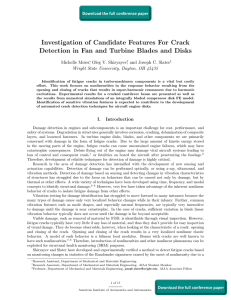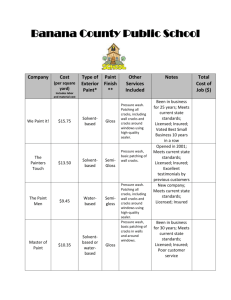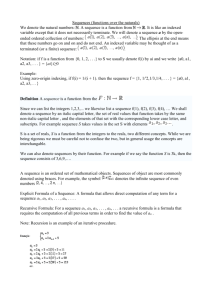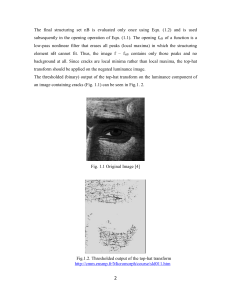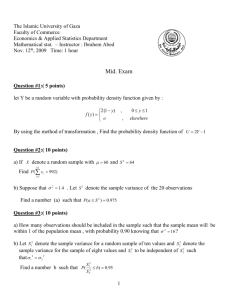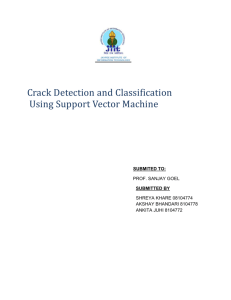Solutions to STA 4032 Assignment 3
advertisement
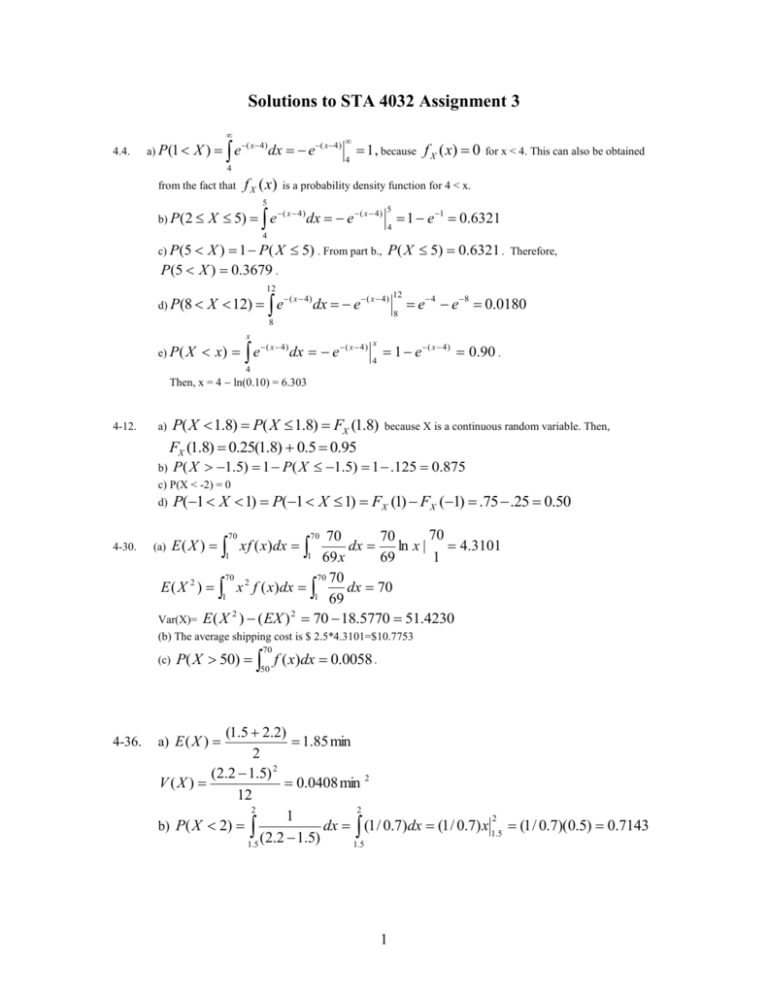
Solutions to STA 4032 Assignment 3 4.4. a) P (1 X ) e ( x4) dx e( x4) 1 , because f X ( x) 0 4 for x < 4. This can also be obtained 4 from the fact that f X (x) is a probability density function for 4 < x. 5 b) P (2 X 5) e ( x 4 ) dx e ( x 4 ) 1 e 1 0.6321 5 4 4 c) P(5 X ) 1 P( X 5) . From part b., P( X 5) 0.6321 . P(5 X ) 0.3679 . 12 d) P(8 X 12) e ( x 4) dx e ( x 4) 12 8 Therefore, e 4 e 8 0.0180 8 x e) P ( X x) e ( x 4) dx e ( x 4 ) x 4 1 e ( x 4) 0.90 . 4 Then, x = 4 ln(0.10) = 6.303 4-12. a) P( X 1.8) P( X 1.8) FX (1.8) FX (1.8) 0.25(1.8) 0.5 0.95 b) P( X 1.5) c) P(X < -2) = 0 d) 1 P( X 1.5) 1 .125 0.875 P(1 X 1) P(1 X 1) FX (1) FX (1) .75 .25 0.50 70 70 70 dx ln x | 4.3101 1 1 69 x 1 69 70 70 70 E ( X 2 ) x 2 f ( x)dx dx 70 1 1 69 2 2 Var(X)= E ( X ) ( EX ) 70 18.5770 51.4230 70 4-30. because X is a continuous random variable. Then, (a) E ( X ) xf ( x)dx 70 (b) The average shipping cost is $ 2.5*4.3101=$10.7753 70 (c) 4-36. P( X 50) f ( x)dx 0.0058 . 50 (1.5 2.2) 1.85 min 2 (2.2 1.5) 2 V (X ) 0.0408 min 2 12 2 2 1 2 dx (1 / 0.7)dx (1 / 0.7) x 1.5 (1 / 0.7)(0.5) 0.7143 b) P( X 2) (2.2 1.5) 1.5 1.5 a) E ( X ) 1 x c) F ( X ) x 1 x 1.5 (2.2 1.5) dy 1.5(1 / 0.7)dy (1 / 0.7) y |1.5 for 1.5 < x < 2.2. Therefore, 0, x 1.5 F ( x) (1 / 0.7) x 2.14, 1.5 x 2.2 1, 2.2 x 4-42. a) P(1 < Z < 1) = P(Z < 1) P(Z <- 1) = 0.84134 0.15866 = 0.68268 b) P(2 < Z < 2) = P(Z < 2) P(Z < -2) = 0.97725-0.02275=0.9545 c) P(3 < Z < 3) = P(Z < 3) P(Z < -3) = 0.99865-0.00135=0.9973 d) P(Z > 3) = 1 P(Z < 3) = 1-0.99865=0.00135 e) P(0 < Z < 1) = P(Z < 1) P(Z < 0) = 0.84134 0.5 = 0.34134 4-48. a) P(X > x) = P Z x 5 = 0.5. 4 Therefore, x = 5. x 5 = 0.95. 4 x 5 Therefore, P Z = 0.05 4 b) P(X > x) = P Z Therefore, x 4 5 = 1.64, and x = 1.56. x5 Z 1 = 0.2. 4 c) P(x < X < 9) = P Therefore, P(Z < 1) P(Z < x 4 5 )= 0.2 where P(Z < 1) = 0.84134. Thus P(Z < x 4 5 ) = 0.64134. Consequently, x 4 5 = 0.36 and x = 6.44. x 5 35 Z = 0.95. 4 4 x 5 x 5 Therefore, P Z P(Z < 0.5) = 0.95 and P Z 0.30854 = 0.95. 4 4 d) P(3 < X < x) = P Consequently, x 5 P Z = 1.25854. Because a probability can not be greater than one, there is 4 no solution for x. In fact, P(3 < X) = P(0.5 < Z) = 0.69146. Therefore, even if x is set to infinity the probability requested cannot equal 0.95. e) This part of the exercise was changed in Printing 3 from P( x < X < x) to 2 P( x < X 5 < x). P( x < X 5 < x) = P(5 x < X < 5 + x) = P 5 x 5 Z 5 x 5 4 4 = P x Z x = 0.99 4 4 Therefore, x/4 = 2.58 and x = 10.32. 4-56. a) P(X > 0.5) = P Z 0.5 0.4 0.05 = P(Z > 2) = 1 0.97725 = 0.02275 0.5 0.4 0.4 0.4 Z 0.05 0.05 b) P(0.4 < X < 0.5) = P = P(0 < Z < 2) = P(Z < 2) P(Z < 0) = 0.47725 c) P(X > x) = 0.90, then P Z x 0.4 = 0.90. 0.05 x 0 .4 Therefore, 0.05 = 1.28 and x = 0.336. 3 4-66. a) P( X 4) i 0 e6 6i 0.1512 i! X 2 N (6, 6 ) P( X 4) P( Z 466 ) P( Z 0.816) 0.2071 b) X is approximately c) P(8 X 12) P( 866 Z 1266 ) P(0.816 Z 2.45) 0.2001 4-68. Let X denote the number of defective chips in the lot. Then, E(X) = 1000(0.02) = 20, V(X) = 1000(0.02)(0.98) = 19.6. a) P( X 25) P Z 25.5 20 P( Z 1.24) 1 P( Z 1.24) 0.107 19.6 b) P(20 X 30) P(20.5 X 29.5) P( .5 Z 19.6 9.5 19.6 ) P(0.11 Z 2.15) =P(Z<2.15)-P(Z<0.11)= 0.9842 0.5438 0.44 4-88. Let X denote the distance between major cracks. Then, X is an exponential random variable with 1 / E ( X ) 0.2 cracks/mile. 3 a) P(X > 10) = 10 10 0.2 x 0.2 x 0.2e dx e e 2 0.1353 b) Let Y denote the number of cracks in 10 miles of highway. Because the distance between cracks is exponential, Y is a Poisson random variable with 10(0.2) 2 cracks per 10 miles. e 2 22 P(Y = 2) = 0.2707 2! c) X 1/ 5 miles. d) P(12 X 15) 0.2e 0.2 x dx e 0.2 x 15 15 12 12 e) P(X > 5) = e 0.2 x e 2.4 e 3 0.0409 e 1 0.3679 . By independence of the intervals in a Poisson 5 process, the answer is 0.36792 0.1353 . Alternatively, the answer is P(X > 10) = e2 0.1353 . The probability does depend on whether or not the lengths of highway are consecutive. f) By the memoryless property, this answer is P(X > 10) = 0.1353 from part e). 4


